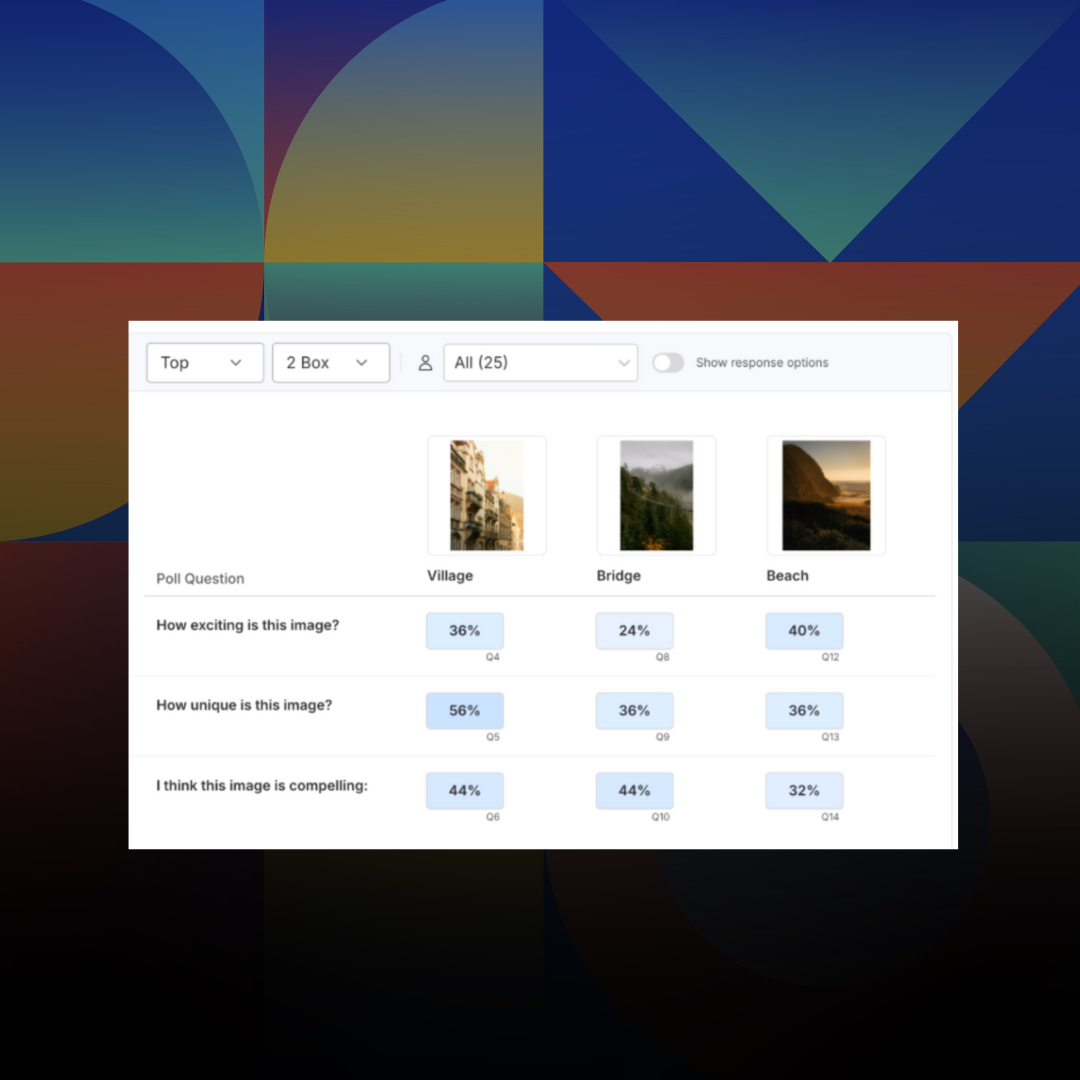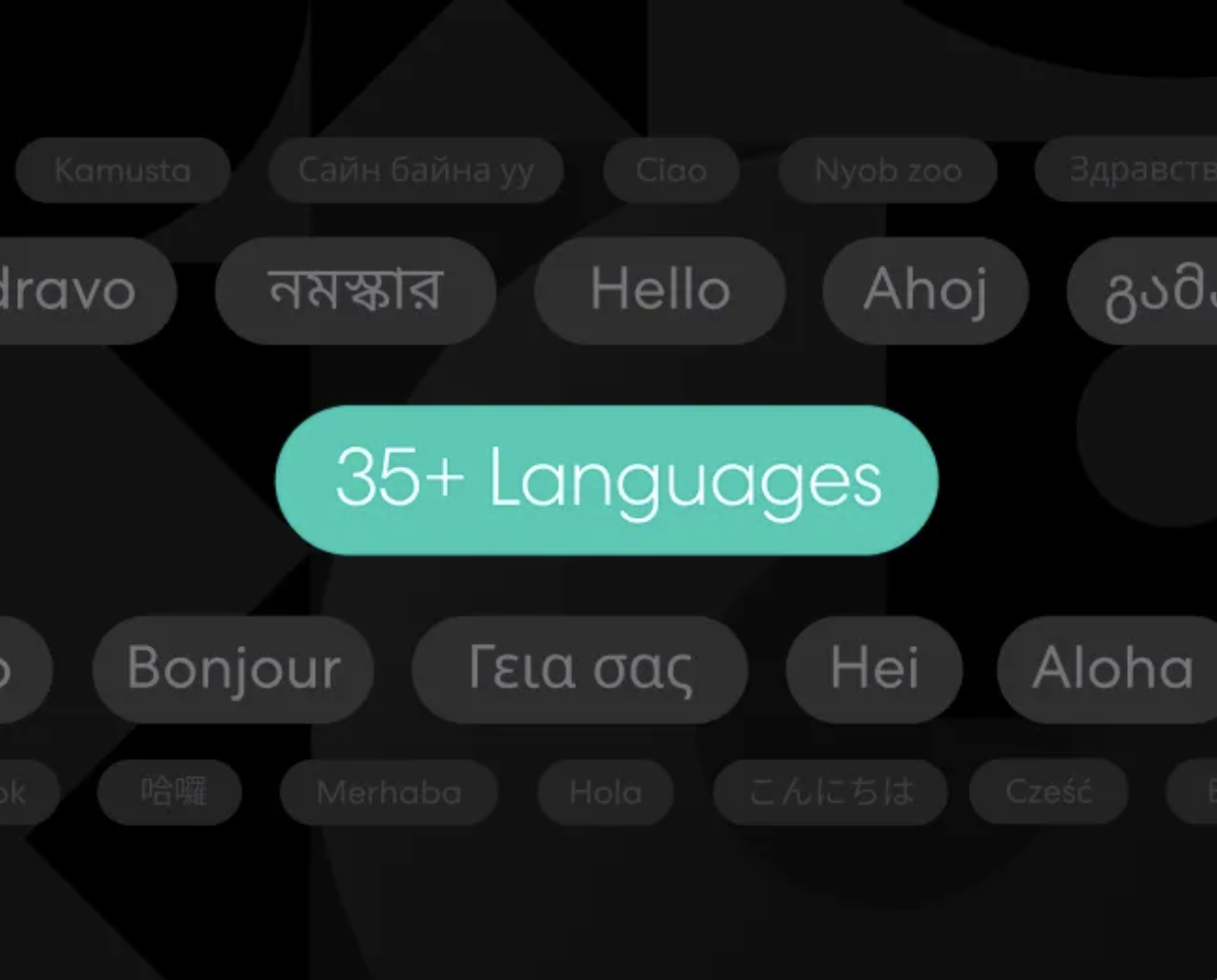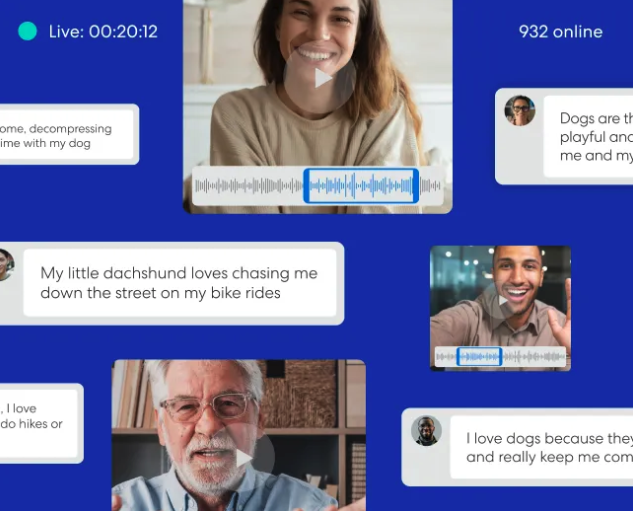
Advanced Research
The Most Cutting-Edge Consumer Insights Software of 2026
Team Remesh
January 5, 2026
Market Research
Articles

Advanced Research
The Most Cutting-Edge Consumer Insights Software of 2026
Team Remesh
January 5, 2026
Market Research
Articles

Research 101
Introducing: Poll Comparison - Streamline Concept Testing and Make Better Decisions Faster
Emmet Hennessy
November 24, 2025
Market Research
Articles

Research 101
Introducing: Poll Comparison - Streamline Concept Testing and Make Better Decisions Faster
Emmet Hennessy
November 24, 2025
Market Research
Articles

AI
Purpose-Built for Research AI is Here - a Letter from the CPO
Jessica Dubin
October 21, 2025
Market Research
Articles

AI
Purpose-Built for Research AI is Here - a Letter from the CPO
Jessica Dubin
October 21, 2025
Market Research
Articles

Advanced Research
Unlock Agile Global Insights: Using Remesh Multi-Language Conversations for Research Across Audiences
Customer Success Team
October 14, 2025
Market Research
Articles

Advanced Research
Unlock Agile Global Insights: Using Remesh Multi-Language Conversations for Research Across Audiences
Customer Success Team
October 14, 2025
Market Research
Articles

AI
The Prompt Is the New Moderator Guide
Anthony Lam
September 16, 2025
Market Research
Articles

AI
The Prompt Is the New Moderator Guide
Anthony Lam
September 16, 2025
Market Research
Articles

AI
Building an AI-Ready Research Stack: Beyond Data Preparation
Anthony Lam
September 9, 2025
Market Research
Articles

AI
Building an AI-Ready Research Stack: Beyond Data Preparation
Anthony Lam
September 9, 2025
Market Research
Articles

AI
Agentic AI for Research: A Practical Primer
Dan Reich
September 2, 2025
Market Research
Articles

AI
Agentic AI for Research: A Practical Primer
Dan Reich
September 2, 2025
Market Research
Articles
3 Qualitative Concept Testing Case Studies & Methods
More than 25% of total revenue and profits across industries are generated by the launch of new products. Yet, the new product launches are often difficult or unsuccessful.



More than 25% of total revenue and profits across industries are generated by the launch of new products. Yet, the new product launches are often difficult or unsuccessful.
Less than half of all product and service launches actually succeed in meeting their targets. This is consistent across both product launches of completely new products and releases of new features to existing products.
What does that mean? Launching incremental improvements to already familiar products can often be fraught with risk.
So how can brands better understand user preferences and reduce the risk for new product and concept ideas?
Enter, the concept test.

What is Concept Testing?
Concept testing is the process of understanding how consumers feel about your product idea prior to its creation or release, and is one component of the larger innovation cycle. This process helps you accurately evaluate whether your product is ready for market.

Companies typically conduct this research in the form of concept test surveys. But concept tests can also come in other forms: customer interviews, focus group discussions, observational studies, and more.
Agile research processes during product development are more crucial today than ever since early-stage concept testing can quickly provide answers to crucial questions, like:
- Why is this concept appealing to my target consumer?
- Which of these concepts should I dedicate resources toward developing further?
- Where are the gaps in the current user experience?
- How well does this concept hold up against competitors?
- Are the benefits of this new idea being effectively communicated to the end-user?
Read: How to Write a Discussion Guide (eBook)

Concept Testing Case Studies
Concept testing seems feasible - but how have prominent brands used the method to boost profits, remain customer-centric, and produce successful products? Here are a few examples.

70% of customers say understanding how they use products and services is very important to winning their business. - Salesforce

Lego
Lego realized that, despite attempts to market their products to females, only 9% of their toy users were young girls.
In an attempt to change their user demographic, Lego embarked on an extended period of concept testing and market research. The goal was to better understand the play habits of young girls.
They realized girls paid more attention to interior layouts and structure details. Girls also preferred building entire environments rather than single structures. These insights allowed new product features to be designed around direct input from Lego’s target demographic.
Lego Friends - a new Lego series marketed at young girls - launched in 2012 and quickly became a hit. The new product tripled the value of construction toys for girls from $300 million to $900 million between 2011 and 2014.

NASCAR
In 2017, NASCAR changed the format of their biggest race. They wanted to gauge viewer experiences following the change. This was an especially important project, since advertising dollars can be influenced positively or negatively based on audience and viewership – and, since NASCAR's audience holds some unique benefits for advertisers.

NASCAR conducted a live Remesh conversation with 200+ super fans to understand viewers’ experiences, thoughts, and reactions to events and advertisements. The conversation helped NASCAR confirm that viewers enjoyed their new structure. They also gained actionable insights that led to the successful rollout of the new race format.

Takasago
In search of innovative flavor and product concept ideas, Takasago wanted to generate new ideas directly with customers. The challenge was that participants in traditional studies tended to provide ideas that were top of mind and close to multiple concepts already in the marketplace. Additionally, Takasago needed a concept testing solution that could be transitioned to an online setting, which is particularly difficult for flavor/taste testing.
Using Remesh, Takasago was able to gauge not only individual consumer responses, but group feedback as well. This information was essential to the brainstorm session because consumers in a group react and build upon one another’s input, rather than referencing what they are familiar with.

How to Conduct a Concept Test
Now that you've seen a few examples of concept testing in action, it's time to break down the strategies behind each project or qualitative test.
Every concept test is naturally unique depending on the objectives and nature of the product. But three broad steps can be followed to write and perform a successful concept test for any product, even in qual research.
Read: 100 Open-Ended Survey Questions

Identify Objectives and Metrics
Start with identifying specific objectives, since these goals will affect every characteristic of your test – for the first step, it may even be a good idea to run concept test surveys or focus groups on the fly to create a baseline.
For instance, if you conduct a product concept test for the launch of a new soda flavor, some possible objectives include:
- Comparing preliminary product concepts for a soda can design, and understanding which one appeals most to consumers
- Doing a deep-dive examination of one version of the new soda, and identifying how customers currently feel about it
After establishing a high-level objective, specific metrics of success will also need to be determined based on that objective. Following the soda design example, some metrics to measure might include:
- Appeal
- Uniqueness
- Purchase intent
- Alignment to the brand
- Material quality
Without an experienced moderator or researcher, it can be difficult to narrow down a set of goals, and therefore multiple concepts, in the end. This specialized role can help a company delve deeper into insights, and is sometimes offered alongside online focus group platforms.

Choosing a Target Audience
After establishing overall objectives, the next step is to identify the target audience you would like to collect consumer responses from.
Take for instance a company that wants to understand how the market feels about a new soda brand concept. They would need a wider sample of a general audience.
Say that same company wanted to evaluate incremental changes to an existing soda can design. In that case, it may be more valuable to source a sample of existing customers who better understand the original product.

Establishing the Testing Methods
The last step of the product concept testing process is to establish the nature of the test design. Some of the most common testing techniques include monadic, sequential monadic, and paired comparison designs.


Monadic Design
A monadic testing method involves introducing participants to a single concept before asking metric-based questions to thoroughly evaluate that one concept. Unmarred by external influence, monadic designs deliver a strong measure of participant sentiment towards a single product.

Testing a product alone offers several advantages, including depth of feedback and effective elimination of order bias. Because you’re only asking participants to evaluate a single concept, you can also afford to keep questionnaires relatively short.

Sequential Monadic Design
Sequential monadic testing is another testing method that involves showing participants several competing concepts in random order. The same set of metric-based questions follow each concept, allowing seamless comparison between concepts.

This test design offers a tremendous advantage in its ability to test multiple concepts without requiring more samples. Smaller sample sizes increase the affordability, speed, and feasibility of product testing.

Paired Comparison Design
Paired comparison design is a testing method that introduces participants to two concepts and ask them to compare the two. This type of testing is particularly effective at measuring subtle differences between concepts, products, or packaging. You can also conduct multiple paired comparison tests, otherwise known as repeated pairs tests.

Showing participants multiple stimuli produces an interaction effect - that is, each stimulus impacts perceptions of successive stimuli. For example, say a participant sees a really strong packaging design first. That participant may score following designs lower than they would have if they had viewed them in isolation.
Watch: Improving CX Through Product Innovation (Webinar)

Use Cases for Concept Testing
There’s theory, and then there’s practice. Here are three specific ways brands can use concept testing in action, but this is by no means a comprehensive list.

Developing New Products and Product Features
One of the most intuitive applications of concept testing lies in helping companies make better decisions when developing new products. This type of product innovation testing can help you better understand:
- What products and features consumers care about
- What pain-points consumers face with existing products

Identifying New Customer Segments
Concept testing also helps you gain a better understanding of current customers. In some instances, this method can even help you identify new potential customer segments for your product, as in the example from a Remesh conversation below.

Concept testing can potentially help you explore the following questions of interest:
- Have the needs and preferences of my target customer segment changed?
- Are there new customers that I can potentially target with this new product concept?

Refining Your Brand's Marketing Strategy
Concept testing can also be used to refine the go-to-market strategy for the launch of a new product.
Using this strategy, your team can better understand:
- What visual and verbal cues customers relate to
- What language customers use to describe their needs and preferences

Next Steps in Product Innovation
The ability to better understand consumer needs is more relevant than ever before. Successful concept testing improves new product development, optimizes marketing strategy, reduces time to market, and keep customers coming back for more.
In this eBook, learn more about how to craft better surveys or focus groups, and organize your data using AI.{{cta('4924012b-eaba-41b9-87de-f1de423074bb')}}
-
Lorem ipsum dolor sit amet, consectetur adipiscing elit. Suspendisse varius enim in eros elementum tristique. Duis cursus, mi quis viverra ornare, eros dolor interdum nulla, ut commodo diam libero vitae erat. Aenean faucibus nibh et justo cursus id rutrum lorem imperdiet. Nunc ut sem vitae risus tristique posuere.
-
Lorem ipsum dolor sit amet, consectetur adipiscing elit. Suspendisse varius enim in eros elementum tristique. Duis cursus, mi quis viverra ornare, eros dolor interdum nulla, ut commodo diam libero vitae erat. Aenean faucibus nibh et justo cursus id rutrum lorem imperdiet. Nunc ut sem vitae risus tristique posuere.
-
More


Introducing: Poll Comparison - Streamline Concept Testing and Make Better Decisions Faster

.png)

.png)
Read More

.png)
.png)
.png)

.png)

.png)
Learn More

.png)
.png)
.png)

Stay up-to date.
Stay ahead of the curve. Get it all. Or get what suits you. Our 101 material is great if you’re used to working with an agency. Are you a seasoned pro? Sign up to receive just our advanced materials.






